Report

Резюме
- Farmer-allied intermediaries strategically buy from commercially oriented smallholder farmers, helping them realize their production potential and increase their incomes.
- They can transform Africa’s agriculture and food systems by reducing poverty, increasing employment and providing affordable, nutritious foods for a growing population.
- Too few farmer-allied intermediaries have reached scale and profitability. Access to capital is often cited as the biggest barrier, but more fundamental systemic bottlenecks may be addressed.
- There is a trade-off between impact and returns. Early-stage intermediaries that purposefully bear the cost of helping smallholder farmers build capacity will need to compromise on financial returns, especially when working with farmers of low-margin staple crops.
- Exponentially greater amounts of philanthropic, patient and blended capital are required to support and grow these critical farmer-allied intermediaries.
- Agricultural transformation requires a new approach that is value chain specific and farmer-allied intermediary anchored and that better aligns and coordinates key actors, targeted outcomes, and types of capital.
This article is the introduction to Bain’s report on Africa’s critical agricultural intermediaries. Explore the contents of the report here or download the PDF to read the full report.
For the past 10 years, a farmer, let’s call her Rosalynn, has operated a small dairy farm in the southern highlands of Tanzania. A one-hour drive on dirt roads from the nearest market town, her farm gate was for years a stopping point for local traders. Moving door to door, those traders wielded significant power, deciding at will not to take a farmer’s milk and often not paying on time or in full. At times when there was more milk than could be traded locally, Rosalynn still had to bear the cost of keeping up her five cows while meeting family expenses.
Five years ago, Asas, a major dairy processor located three hours away in Iringa, began sourcing milk from Rosalynn’s village. Asas set up a network of milk collection stations along rural roads where farmers now take their milk twice a day for testing and collection by Asas employees who then transport the milk to a chilled collection center.
Asas buys from farmers all year round, taking as much quality output as they can produce and paying them a fair price, on time, every two weeks, directly deposited into cooperative bank accounts. This provides steady demand and a predictable source of income for Rosalynn and her family.
In addition, Asas extension agents provide farmers with training to improve cow productivity, educate them in climate-smart agricultural practices, and deliver veterinary support and inputs, such as minerals that can be purchased on credit to supplement cattle diets. Rosalynn now sells her milk to Asas at a station only one mile from her farm, and with their support, she has improved her cows’ health and nearly doubled their productivity from 6 liters per cow per day to 10 liters or more per cow per day.
In the time that Rosalynn has exclusively sold her milk to Asas, she has saved enough money, thanks to the increased productivity of her herd, to purchase two additional high-yielding, crossbred heifers. Moreover, she now is able to provide her two sons and daughter with a nutritious glass of fresh milk every day without worrying about needing to sell as much milk as possible to maintain an income. Her income overall has increased, and that allows her to have more money for food and other expenses; it also allows her to save for her children’s college education.
Rosalynn’s experience is representative of many commercially oriented smallholder farmers we have spoken to in this region of Tanzania in recent months. Asas offers them a way to reach the market that is more sustainable and profitable than traditional traders did.
By sparking activity across the dairy value chain—in processing, packaging, logistics and retail—Asas helps to ensure a reliable supply of high-quality milk to Tanzanian consumers and at the same time contributes to an expanded tax revenue base for local governments. If properly scaled, this can provide hundreds of jobs for young men and women, including extension officers who train farmers on better practices, milk collection agents, quality control officers, testing lab technicians and processing plant workers directly employed by Asas. And there are nutritional benefits, too. Processed dairy products are safer to consume than raw milk, and they can dramatically improve the nourishment of at-risk segments of the population, such as children under five years old and expectant mothers.
Asas is an example of a different kind of middleman that we call a farmer-allied intermediary, a group with the potential to transform food systems in Africa.
Intermediaries are farmer allied when they invest in enhancing smallholder farmer livelihoods and disrupt traditional, transaction-oriented sales channels, such as traders (see Figure 1).
What does a smallholder farmer-allied intermediary do differently?

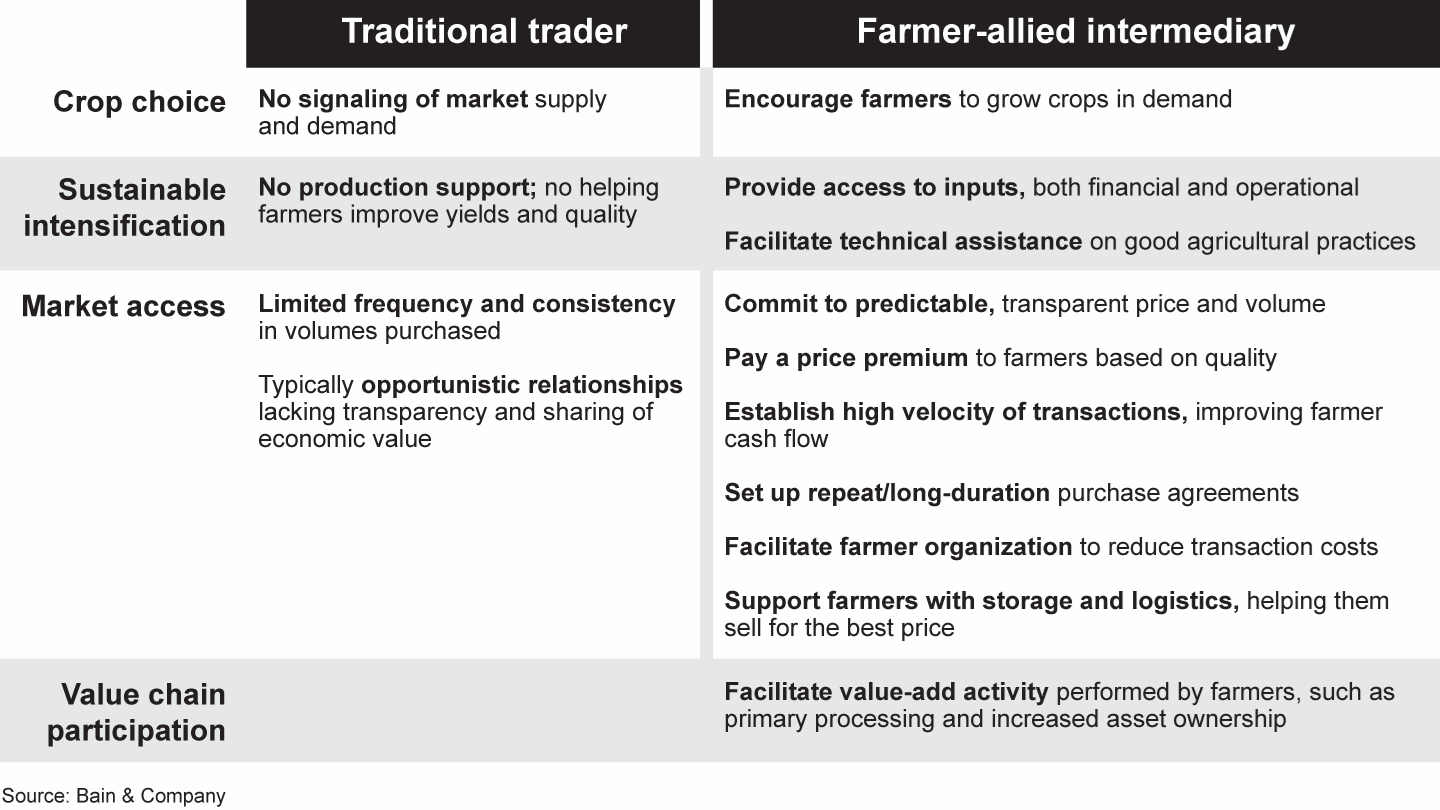
A new paradigm of agricultural development
In order to feed and employ the fastest-growing population in the world, we need a new approach to agricultural development in Africa, one with farmer-allied intermediaries at its center (see Figure 2).
There are four main models of farmer-allied intermediaries connecting farmers to market

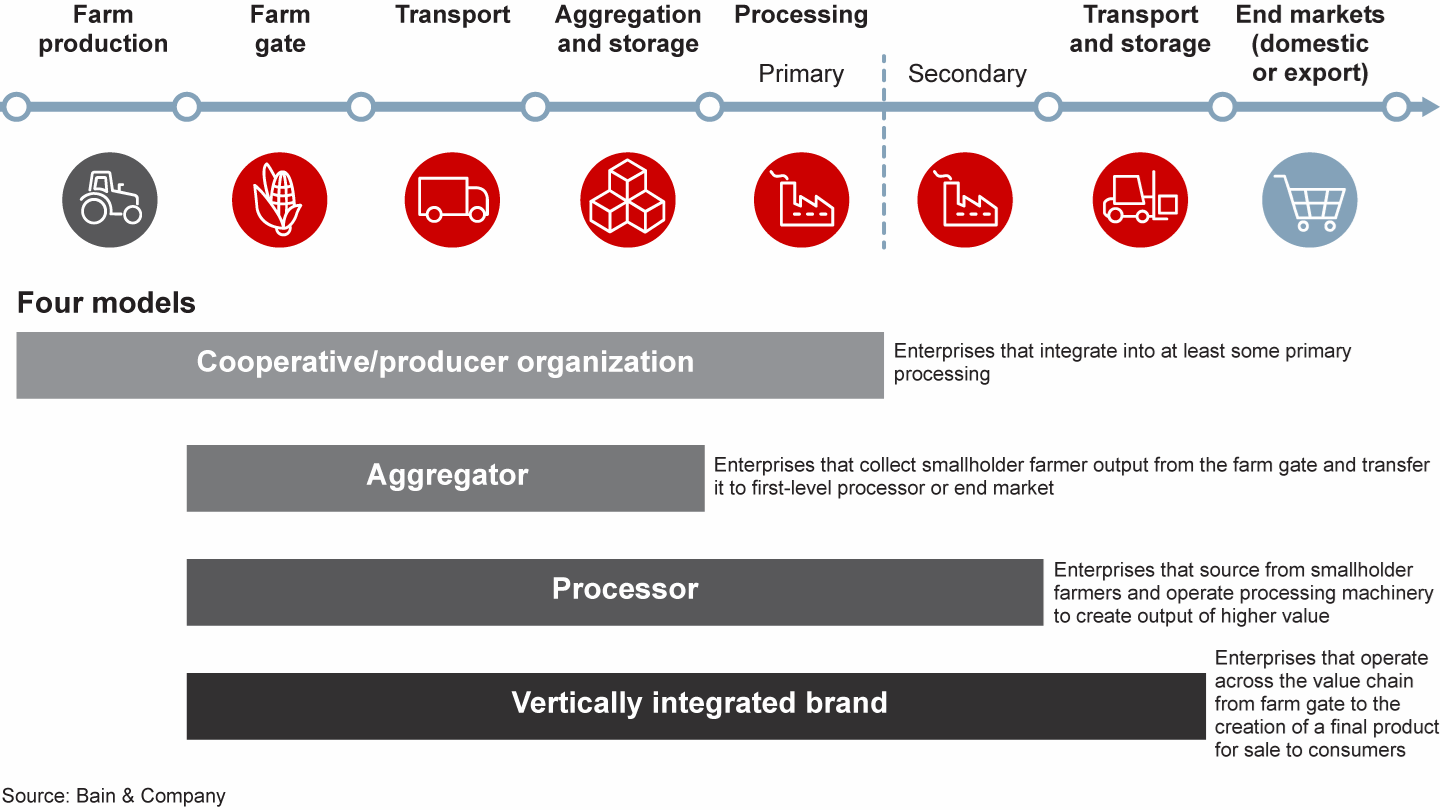
Working hand in hand with smallholder farmers, farmer-allied intermediaries, including producer organizations, aggregators, processors and vertically integrated food brands, can simultaneously achieve a number of critically important outcomes for a broad set of stakeholders. These include enhancing the livelihood of smallholder farmers and alleviating rural poverty, delivering quality agricultural output to buyers, creating a more efficient sales channel for input providers, making more nutritious food available to Africa’s growing populations, and creating jobs and contributing to broader economic development (see Figure 3).
Farmer-allied intermediaries benefit many stakeholders

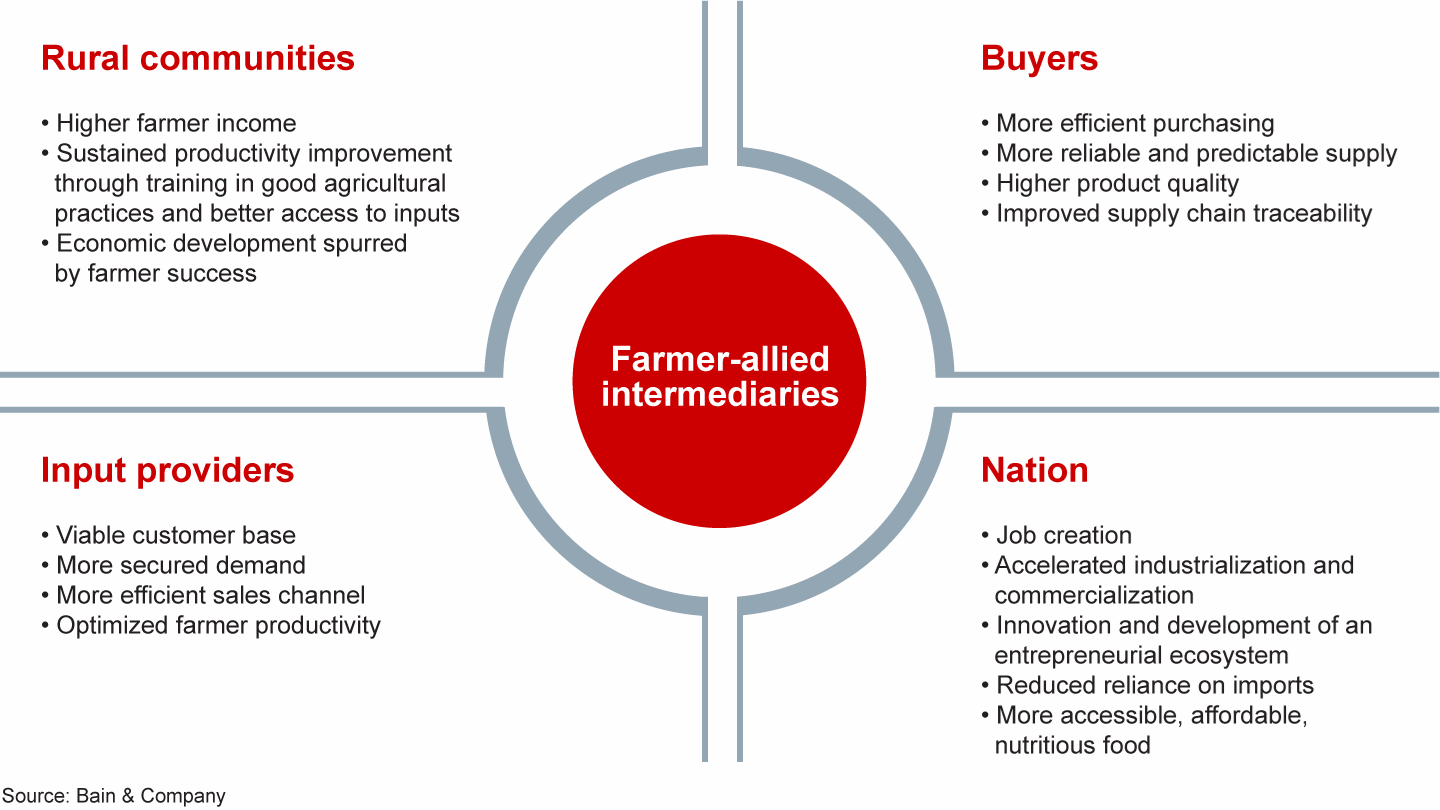
This approach to agricultural transformation is consistent with the United Nations’ goals for sustainable development (see Figure 4).
Food systems centered on farmer-allied intermediaries can advance many of the UN’s 17 Sustainable Development Goals

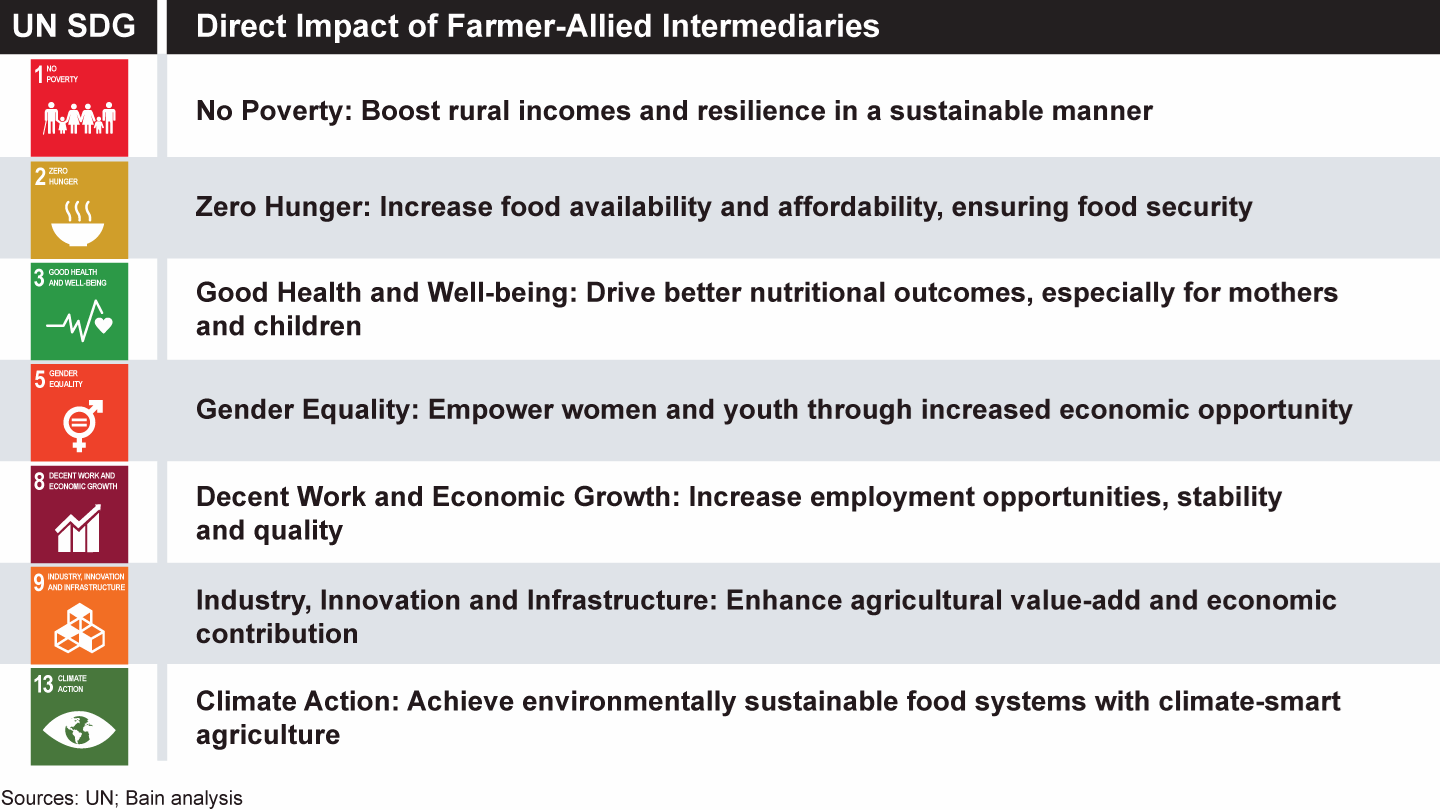
In many sub-Saharan African countries, smallholder farming will continue to dominate food production for the foreseeable future, and agricultural transformation will require a critical number of scaled, profitable and competitive intermediaries allied with those farmers. Those farmer-allied intermediaries will need a well-functioning system—optimal upstream and downstream conditions as well as in the broader operating environment—in order to grow and thrive.
A new approach is needed. Business as usual simply cannot address the magnitude of the region’s current challenges. Over the past two decades, donor countries, multilaterals and foundations have directed almost $40 billion to African agriculture, according to our analysis of data from the UN’s Food and Agriculture Organization as well as the Organisation for Economic Co-operation and Development. Yet food security in the region remains about half that of developed markets. Net food imports have risen 400% since the early 2000s and, barring intervention, are projected to soar to more than $110 billion by 2025. While agriculture is the largest segment of the economy in many sub-Saharan African countries, frequently accounting for between 30% and 70% of employment and comprising approximately one-quarter of the region’s overall GDP, the portion of economic value captured beyond the farm gate is half the global average. And poverty levels, measured by the percentage of the population living on less than $5.50 per day, are almost 2 times higher in Africa than the global average (see Figure 5). Furthermore, due to their underdeveloped food systems and low purchasing power, many African consumers spend up to half their income on food.
Agricultural conditions in Africa are growing more challenging

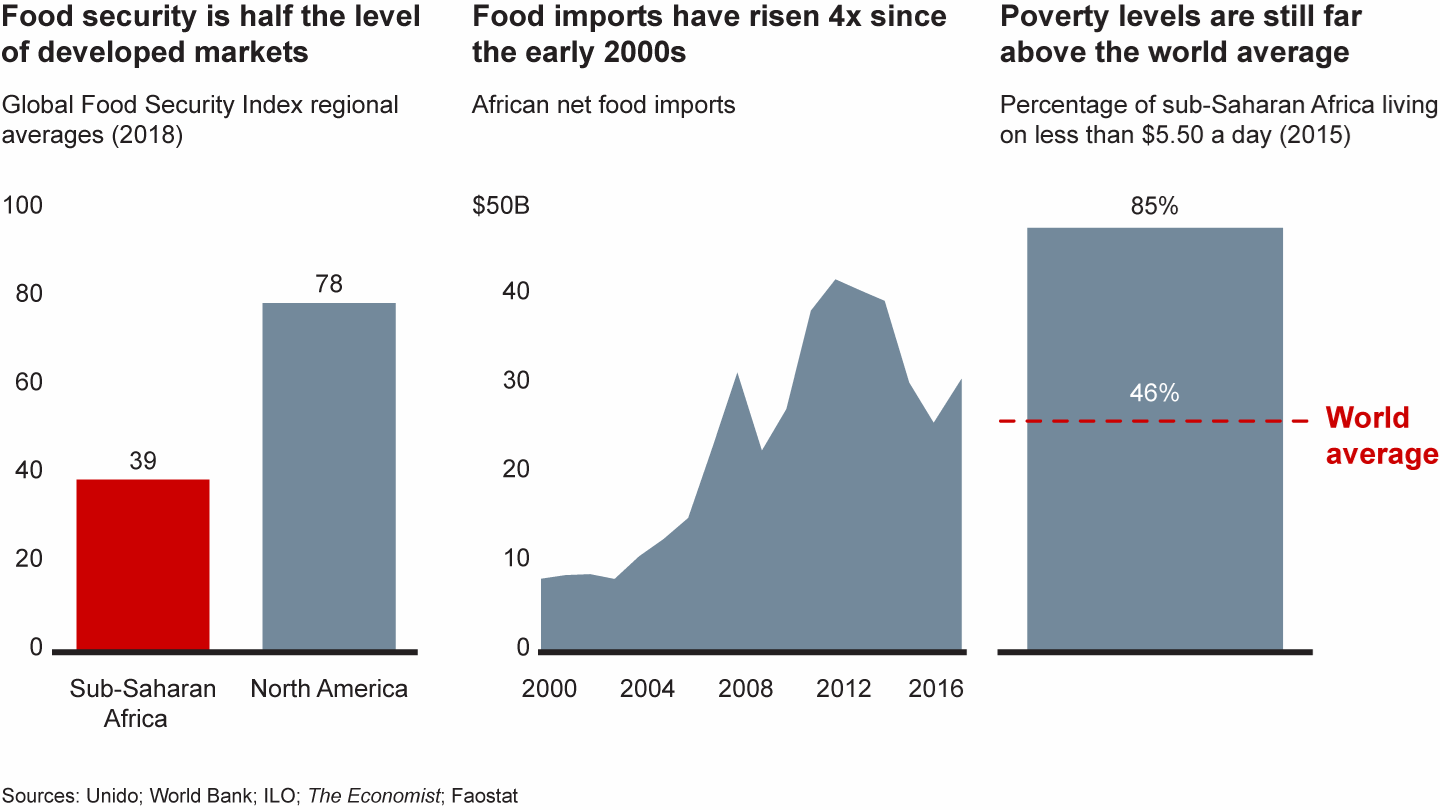
All of these issues will get worse as increasing urbanization puts further pressure on domestic food systems and climate change becomes a bigger threat to African agricultural production. We are facing a perfect storm, and we need a new approach to agricultural development in Africa to feed and employ the fastest-growing population in the world.
To transform Africa’s food system successfully, we must put farmer-allied intermediaries at the center of our efforts.
Too few, too small
There are farmer-allied intermediaries pioneering successful models of impact and innovation, as well as broader ecosystems that are effectively supporting those intermediaries. Unfortunately, too few farmer-allied intermediaries exist in sub-Saharan Africa today, and many of those that do struggle to scale profitably.
Even for Asas, one of the largest dairy processors in Tanzania, it’s a battle to achieve sustained profitability. At times, Asas operates at only 20% capacity, well below break-even utilization. Securing a consistent, high-quality supply from its base of more than 3,000 smallholder farmers can be challenging, especially during the dry season. Asas has borne the cost of collecting milk from this dispersed group and of developing a system for working with them. That system includes an in-house database with a linked app for farmer registration and tracking as well as a variety of farmer supports from training to providing inputs on credit to mineral distribution and veterinary services. At the same time, Asas is fighting deeply entrenched consumer preferences for raw milk as well as managing expenses that add to the cost of operation and ultimately to product prices, pushing them out of reach for many consumers. Despite these challenges, Asas has remained committed to its smallholder farmer base, intentionally choosing to rely predominantly on them for its supply rather than concentrating on scaling, as it might, a handful of large commercial farms near its processing plant, including its own.
The development community knows well the broader challenges of scaling profitable farmer-allied intermediaries and agricultural small and medium-sized enterprises (SMEs). The biggest is access to financing.
Historically, development programs have not prioritized intermediaries, instead largely focusing their grant funds on interventions to increase farmer productivity. The financing gap extends beyond grants to debt and equity as well. According to recent research, there is an $80 billion gap in debt available for agricultural SMEs with annual revenue less than $15 million. This stems mainly from the quantum of credit available, but even what credit does exist is not always affordable with interest rates of 15% to 30%. Such high interest is hard to pay off with the meager cash flows from agricultural or food production.
One study of more than 100,000 SMEs predominantly located in developing countries found that access to financing was respondents’ No. 1 challenge. And in our own research over the past year, we have heard agricultural intermediaries talk about the difficulty of securing loans for working capital and capital expenditures. In addition to high interest rates, they are limited by a lack of collateral and payment terms that may require repayment even before new cash flows materialize.
Agricultural SMEs have historically not received significant equity investment. Our research has found that agriculture as a sector has attracted less than 10% of all impact capital invested in sub-Saharan Africa in recent years. Between 2013 and 2018, roughly 20% of this capital went to agricultural SMEs, and of that, less than 20% went to agricultural intermediaries in the “missing middle,” a segment that includes most smallholder farmer-allied intermediaries. That amounts to less than 1% of the estimated $6 billion in impact capital, on average, deployed to sub-Saharan Africa per year during this period.
To calculate the total impact capital directed to sub-Saharan Africa, Bain looked at global development finance institution (DFI) equity flows to the region as well as all non-DFI equity flows between 2012 and June 2018, using Pitchbook deal data, a comprehensive literature search and analysis of major investor company portfolios. Estimates for the proportion of impact capital directed toward agriculture, specifically, in sub-Saharan Africa, is based on our literature search. To calculate the proportion of capital that went to intermediaries in the “missing middle,” we looked at 275 companies from Pitchbook and conducted a portfolio analysis of 26 leading DFI and non-DFI equity investors and classified investees by company revenue (microenterprise, “missing middle” and larger SMEs) and by business model (ag tech, input providers, intermediaries and other agribusinesses).
“Missing middle” is a term that has emerged over the past decade, along with “small and growing businesses” and “pioneer firms,” to characterize a specific type of SME. This group typically comprises early-stage firms underserved by commercial lenders and investors but nevertheless considered too big by microfinance institutions (see Figure 6). For this report, we have loosely defined the missing middle as enterprises with 5 to 250 employees and revenue between $100,000 and $5 million that are seeking debt or equity capital of $200,000 to $2 million. These firms typically fit into the “validate” and “prepare” phases defined in From Blueprint to Scale, a report by Monitor and Acumen.
Farmer-allied intermediaries often fall in the missing middle, where financing is not readily available

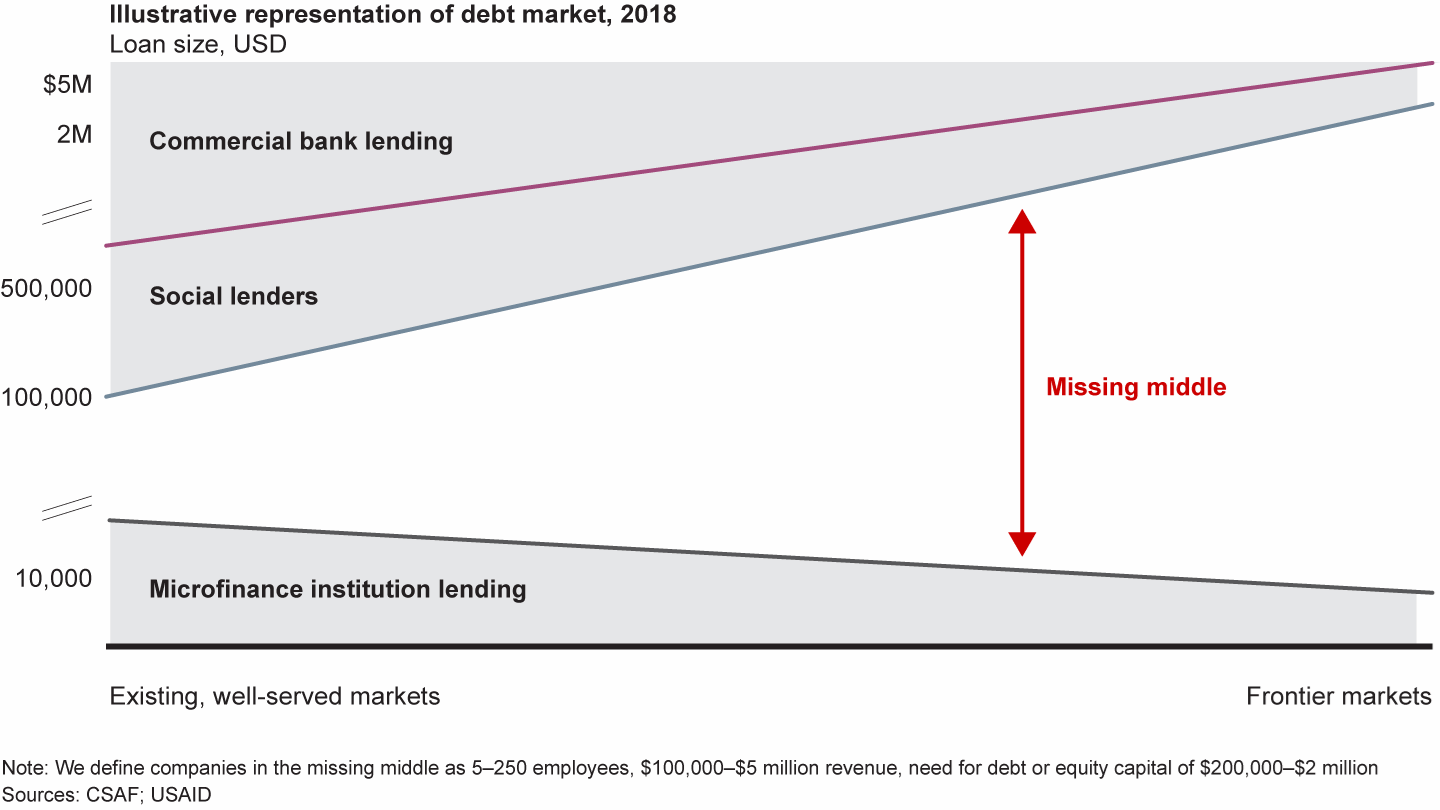
In limiting their financing, bankers and investors are for the most part simply acting rationally. There is always a higher level of systemic risk in agriculture relative to other sectors. Factors such as weather and pestilence, both exacerbated by climate change, are hard to predict and can significantly hurt an enterprise’s performance.
But the challenge of financing farmer-allied intermediaries has its specific complexities as well. The first challenge to becoming commercially viable and scalable and, in turn, able to secure credit and equity investment is acquiring sufficient, reliable quantities of quality raw materials from smallholder farmers, and doing so at a price that allows the intermediary to meet market demand and earn a profit. As Asas’s experience in Tanzania shows, working with small, dispersed farms involves complex and costly logistics and distribution. Investments in organizing and training farmers and providing access to a full range of necessary inputs, often on credit, can be necessary to build farmer loyalty and ensure the right quantity and quality of output.
The intermediary’s intent ultimately determines how it engages with smallholder farmers and the degree to which it invests in them. While farmer engagement and investment typically strengthen loyalty and reliability, thereby serving the long-term financial interests of the business, in the near to medium term, they come at a cost and imply a real trade-off with financial performance and returns. This trade-off is especially acute for early-stage entrepreneurs that are still building their business models and operating in limited parts of lower-margin value chains. Emphasis on farmer investment for these entrepreneurs could mean a slower path to scale and positive financial returns.
Indeed, it takes time and effort to build a repeatable business model that both delivers a value proposition to farmers strong enough to disrupt traditional trader relationships and maximizes operating efficiency enough to enable positive unit economics. It requires access to managerial, financial and technical expertise that is often in short supply. It can be difficult to secure predictable, growing demand. Sometimes, the challenge involves shaping consumer behavior, such as drinking processed milk; other times, it may be addressing the complexities of a multichannel retail landscape. Navigating the often opaque and unpredictable regulatory and policy environment, including import regulations and tariffs, value-added taxes, and company and product registrations, is yet another trial they face.
In short, while the “access to financing” challenge often cited by these firms is real, it also can mask a host of underlying, interrelated challenges across a complex ecosystem. For farmer-allied intermediaries to scale profitably takes more than business acumen and entrepreneurial drive. It requires a well-functioning system: conditions within and surrounding the value chain that enable farmer-allied intermediaries to scale profitably. In many sub-Saharan countries, that system does not exist or function adequately. To build it requires a new approach to smallholder agricultural development and investing—one that prioritizes high-potential farmer-allied intermediaries and brings together different kinds of support in a far more aligned, coordinated way (see Figure 7). It requires capital from philanthropic, commercial and blended sources as well as supports beyond capital, including strategic and operational assistance that come from public, social and private sectors.
Supporting farmer-allied intermediaries requires the right business model operating in the right system

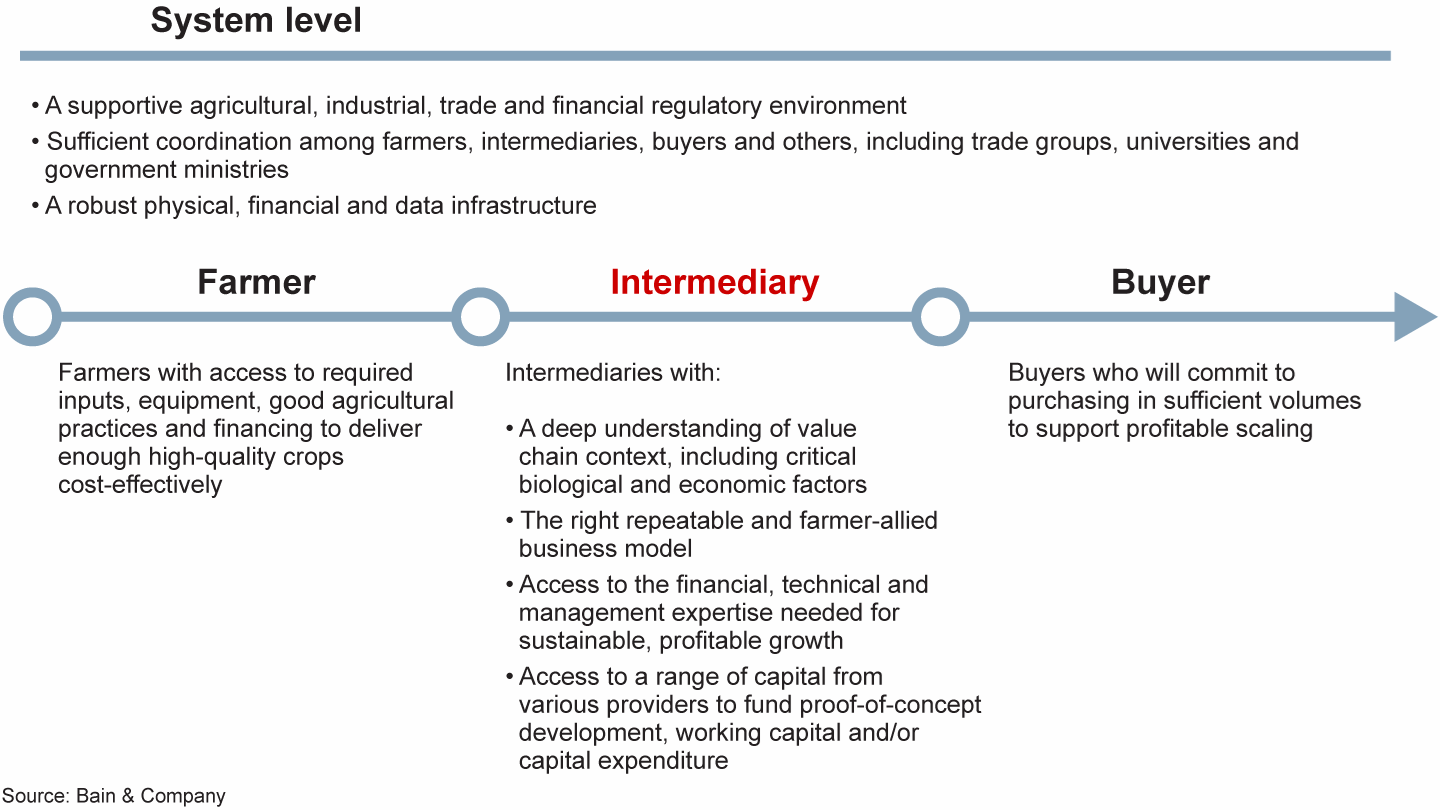
As we will see throughout this report, these complex challenges can be addressed. Digital technologies and emerging models of success are providing momentum and the opportunity to build a new, more effective approach to agricultural transformation.